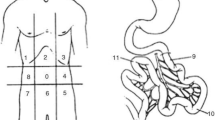Abstract
Background
Cytoreductive surgery and hyperthermic intraperitoneal chemotherapy (CRS/HIPEC) for patients with low-grade mucinous adenocarcinoma (LGMA) is most effective when complete cytoreduction is achieved. We externally validated two radiographic scoring systems to predict resectability and assessed radiographic response to systemic chemotherapy (SCT).
Methods
Patients with LGMA who received preoperative SCT followed by CRS/HIPEC from 2013 to 2016 were identified. CT scans were graded by six physicians using the simplified radiologic score (SRS) and simplified preoperative assessment of appendiceal tumor (SPAAT) systems. Positive and negative predictive values (PPV, NPV) were calculated by comparing to completeness of cytoreduction. Inter-rater agreement was assessed using the intraclass correlation coefficient (ICC).
Results
Twenty-four patients had preoperative SCT followed by CRS/HIPEC. Thirteen patients underwent incomplete CRS and 11 patients complete CRS. Scoring of the preoperative CT had a PPV of complete cytoreduction of 75% and 66.7% for SRS and SPAAT, respectively. NPV was 83.4% and 88.9% for SRS and SPAAT, respectively. ICC for the preoperative SRS and SPAAT score was 0.826 (95% confidence interval [CI]: 0.720–0.910] and 0.788 [0.667–0.888). Comparison of CT scans before and after SCT recorded an increase in calculated scores in 45.8% (SRS) and 50% (SPAAT) of patients.
Conclusions
External validation of two radiographic scoring systems to predict complete cytoreduction showed that inter-rater agreement for both systems was good. Both scoring systems predicted incomplete cytoreduction. Applying a systematic approach to preoperative imaging review is recommended to improve treatment selection by minimizing morbidity associated with incomplete CRS and help to set patient expectations.

Similar content being viewed by others
References
Elias D, Gilly F, Quenet F, et al. Pseudomyxoma peritonei: a French multicentric study of 301 patients treated with cytoreductive surgery and intraperitoneal chemotherapy. Eur J Surg Oncol. 2010;36(5):456–62.
Moran BJ, Cecil TD. The etiology, clinical presentation, and management of pseudomyxoma peritonei. Surg Oncol Clin N Am. 2003;12(3):585–603.
Chua TC, Moran BJ, Sugarbaker PH, et al. Early- and long-term outcome data of patients with pseudomyxoma peritonei from appendiceal origin treated by a strategy of cytoreductive surgery and hyperthermic intraperitoneal chemotherapy. J Clin Oncol. 2012;30(20):2449–56.
Sugarbaker PH, Chang D. Results of treatment of 385 patients with peritoneal surface spread of appendiceal malignancy. Ann Surg Oncol. 1999;6(8):727–31.
Chua TC, Yan TD, Smigielski ME, et al. Long-term survival in patients with pseudomyxoma peritonei treated with cytoreductive surgery and perioperative intraperitoneal chemotherapy: 10 years of experience from a single institution. Ann Surg Oncol. 2009;16(7):1903–11.
Sugarbaker PH. Epithelial appendiceal neoplasms. Cancer J (Sudbury, Mass.). 2009;15(3):225–35.
Baratti D, Kusamura S, Mingrone E, Balestra MR, Laterza B, Deraco M. Identification of a subgroup of patients at highest risk for complications after surgical cytoreduction and hyperthermic intraperitoneal chemotherapy. Ann Surg. 2012;256(2):334–41.
de Bree E, Koops W, Kroger R, van Ruth S, Witkamp AJ, Zoetmulder FA. Peritoneal carcinomatosis from colorectal or appendiceal origin: correlation of preoperative CT with intraoperative findings and evaluation of interobserver agreement. J Surg Oncol. 2004;86(2):64–73.
Dohan A, Hoeffel C, Soyer P, et al. Evaluation of the peritoneal carcinomatosis index with CT and MRI. Br J Surg. 2017;104(9):1244–9.
Klumpp B, Aschoff P, Schwenzer N, et al. Correlation of preoperative magnetic resonance imaging of peritoneal carcinomatosis and clinical outcome after peritonectomy and HIPEC after 3 years of follow-up: preliminary results. Cancer Imaging. 2013;13(4):540–7.
Low RN, Barone RM. Combined diffusion-weighted and gadolinium-enhanced MRI can accurately predict the peritoneal cancer index preoperatively in patients being considered for cytoreductive surgical procedures. Ann Surg Oncol. 2012;19(5):1394–401.
Passot G, Glehen O, Pellet O, et al. Pseudomyxoma peritonei: role of 18F-FDG PET in preoperative evaluation of pathological grade and potential for complete cytoreduction. Eur J Surg Oncol. 2010;36(3):315–23.
Dineen SP, Royal RE, Hughes MS, et al. A simplified preoperative assessment predicts complete cytoreduction and outcomes in patients with low-grade mucinous adenocarcinoma of the appendix. Ann Surg Oncol. 2015;22(11):3640–6.
Bouquot M, Dohan A, Gayat E, et al. Prediction of resectability in pseudomyxoma peritonei with a new CT score. Ann Surg Oncol. 2018;25(3):694–701.
Koo TK, Li MY. A guideline of selecting and reporting intraclass correlation coefficients for reliability research. J Chiropr Med. 2016;15(2):155–63.
Dineen SP, Royal RE, Mansfield PF, Fournier KF. Comment on: External validation of the simplified preoperative assessment for low-grade mucinous adenocarcinoma of the appendix. Ann Surg Oncol. 2017;24(Suppl 3):627.
Milovanov V, Sardi A, Aydin N, Nieroda C, Sittig M, Gushchin V. External validation of the simplified preoperative assessment for low-grade mucinous adenocarcinoma of the appendix. Ann Surg Oncol. 2017;24(7):1783–6.
Menassel B, Duclos A, Passot G, et al. Preoperative CT and MRI prediction of non-resectability in patients treated for pseudomyxoma peritonei from mucinous appendiceal neoplasms. Eur J Surg Oncol. 2016;42(4):558–66.
Chandramohan A, Thrower A, Smith SA, Shah N, Moran B. “PAUSE”: a method for communicating radiological extent of peritoneal malignancy. Clin Radiol. 2017;72(11):972–80.
Shaib WL, Assi R, Shamseddine A, et al. Appendiceal mucinous neoplasms: diagnosis and management. Oncologist. 2017;22(9):1107–16.
Baratti D, Kusamura S, Nonaka D, et al. Pseudomyxoma peritonei: clinical pathological and biological prognostic factors in patients treated with cytoreductive surgery and hyperthermic intraperitoneal chemotherapy (HIPEC). Ann Surg Oncol. 2008;15(2):526–34.
Author information
Authors and Affiliations
Corresponding author
Ethics declarations
Disclosure
No financial or material disclosures to report.
Additional information
Publisher's Note
Springer Nature remains neutral with regard to jurisdictional claims in published maps and institutional affiliations.
Rights and permissions
About this article
Cite this article
Sabesan, A., Felder, S., Feuerlein, S. et al. Preoperative Radiographic Assessment Predicts Incomplete Cytoreduction in Patients with Low Grade Mucinous Adenocarcinoma of the Appendix. Ann Surg Oncol 27, 165–170 (2020). https://doi.org/10.1245/s10434-019-07676-2
Received:
Published:
Issue Date:
DOI: https://doi.org/10.1245/s10434-019-07676-2




